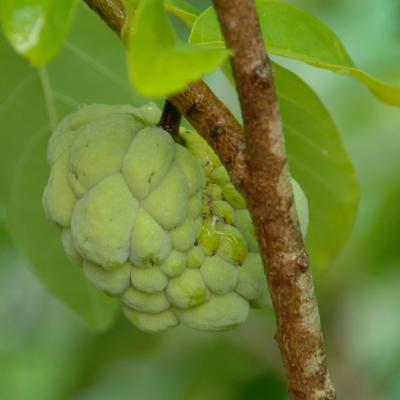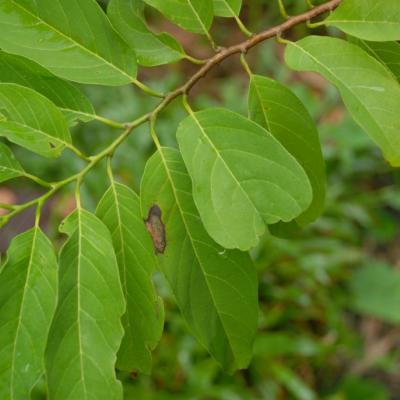Annonaceae-Annona-squamosa
Classification
- Botanical Family : Annonaceae
- Genus : Annona
- Epithet : squamosa
- German Family Name: Annonengewächse
- English Name: Sugar Apple
- Thai Name: น้อยหน่า
- Thai Phonetic: noi naa
- Author: L.
- Height: 4.00
Water Requirements
Plant Type
Light Requirements
Cultivation
Grows in high rainfall and wet-dry areas. It needs plenty of water during the growth phase, but can survive in long dry periods leafless.
Annona squamosa ist weltweit in tropischen und subtropischen Gebieten einer der beliebtesten Obstbäume. Es ist ein kleiner, laubabwerfender Baum bis ca. 4 m Höhe, der wegen seiner schmackhaften Früchte kultiviert wird.
Das Artepitheton squamosa stammt aus dem Lateinischen und bedeutet „schuppig“. Es beschreibt die beschuppten Früchte.
Die Blüten sind klein und von weiß-grünlicher Farbe mit einem angenehmen Duft. Das Fruchtfleisch ist weiß, süß und mild im Geschmack, zergeht cremeweich auf der Zunge. Zum Verzehr werden die reifen Früchte aufgebrochen und ohne Schalen und Samen aus der Hand gegessen oder ausgelöffelt. Das Fruchtfleisch wird auch zu Eis verarbeitet oder mit Wasser gemischt als Getränk verwendet. Die Kerne der Samen sind jedoch giftig und verursachen Darmbeschwerden. Unzerkaute, verschluckte Samen mit intakter Schale sind jedoch harmlos. Es werden inzwischen Sorten ohne Kerne kultiviert.
Wächst in niederschlagsreichen und wechselfeuchten Gebieten. Er braucht in der Wachstumsphase ausreichend Wasser, kann aber auch lange Trockenzeiten blattlos überstehen.
Vermehrung: Annona squamosa kann sehr einfach aus Samen gezogen werden. Es dauert dann ca. 2 Jahre bis zur ersten Blüte.
Origin
Miscelaneous
Ethnomedical uses
The ethnomedical information is provided for general information only, it is not intended as guidance for medicinal use.
Poultices from the leaves are used to treat wounds and ulcers but also for epilepsy.The decoction is digestion and is also used for rheumatic fever. The seed powder is used as an insecticide. The leaves, fruits and seeds are against intestinal wormes. The unripe fruit is astringent and is used for diarrhea and dysentery. The bark is astringent and is regarded as a tonic. From the roots is made a laxative. (1)
Annona squamosa was tested successfully continue studies in:
- in Diabetes (2)
- for head lice (3)
(1) http://stuartxchange.com/Atis.html
(2) Antidiabetic activity of aqueous leaf extract of Annona squamosain streptozotocin–nicotinamide type 2 diabetic rats Annie Shirwaikar, K. Rajendran, C. Dinesh Kumar, Ramgopal Bodla, Department of Pharmacognosy, College of Pharmaceutical Sciences, Manipal 576119, India Received 8 August 2003. Revised 22 September 2003. Accepted 11 December 2003. Available online 6 February 2004. http://www.sciencedirect.com/science/article/pii/S0378874103004604
(3) ANTI-HEAD LICE EFFECT OF ANNONA SQUAMOSA SEEDS / Junya Intaranongpai Department of Pharmacognosy, Faculty of Pharmacy, Mahidol University, Bangkok; Department of Chemistry, Faculty of Science, Chulalongkorn University, Bangkok, Thailand SOUTHEAST ASIAN J TROP MED PUBLIC HEALTH • Vol 37 No. 3 May 2006 http://www.tm.mahidol.ac.th/seameo/2006_37_3/16-3806.pdf
Volksmedizinische Verwendung
Die Berichte über volksmedizinische Verwendung ist nur zur allgemeinen Information und nicht als medizinischer Ratgeber zu betrachten.
Verwendet werden Wurzel, Blätter und Rinde.
Breiumschläge aus den Blättern werden zur Behandlung von Wunden und Geschwüren aber auch gegen Epilepsie verwendet. Der Blattsud ist verdauungsfördernd und wird auch für Rheumabäder und zum Fiebersenken verwendet. Das Samenpulver wird als Insektizid eingesetzt. Die Blätter, Früchte und Samen sind Mittel gegen Darmwürmer. Die unreife Frucht ist adstringierend und wird verwendet bei Durchfall und Ruhr. Die Rinde ist adstringierend und gilt als Stärkungsmittel. Aus den Wurzeln wird ein Abführmittel hergestellt. (1)
Weiterhin wurde Annona squamosa erfolgreich in Studien getestet:
- bei Diabetis (2)
- gegen Kopfläuse (3)
(1) http://stuartxchange.com/Atis.html
(2) Antidiabetic activity of aqueous leaf extract of Annona squamosain streptozotocin–nicotinamide type 2 diabetic rats Annie Shirwaikar, K. Rajendran, C. Dinesh Kumar, Ramgopal Bodla, Department of Pharmacognosy, College of Pharmaceutical Sciences, Manipal 576119, India Received 8 August 2003. Revised 22 September 2003. Accepted 11 December 2003. Available online 6 February 2004. http://www.sciencedirect.com/science/article/pii/S0378874103004604
(3) ANTI-HEAD LICE EFFECT OF ANNONA SQUAMOSA SEEDS / Junya Intaranongpai Department of Pharmacognosy, Faculty of Pharmacy, Mahidol University, Bangkok; Department of Chemistry, Faculty of Science, Chulalongkorn University, Bangkok, Thailand SOUTHEAST ASIAN J TROP MED PUBLIC HEALTH • Vol 37 No. 3 May 2006 http://www.tm.mahidol.ac.th/seameo/2006_37_3/16-3806.pdf


